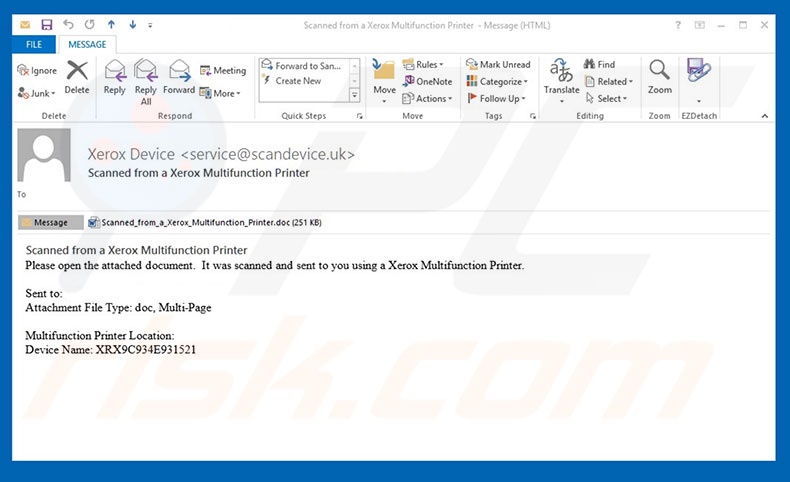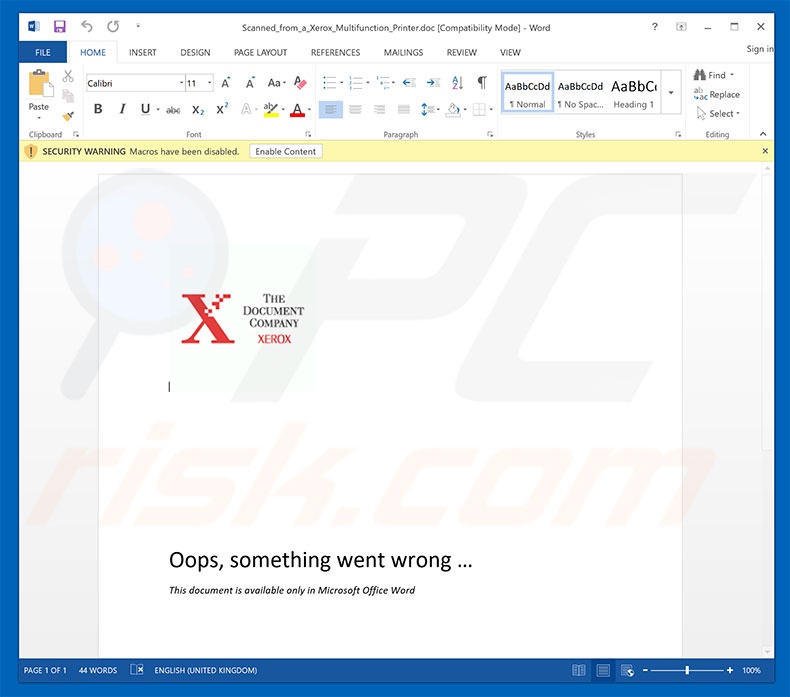Get free scan and check if your device is infected.
Remove it nowTo use full-featured product, you have to purchase a license for Combo Cleaner. Seven days free trial available. Combo Cleaner is owned and operated by RCS LT, the parent company of PCRisk.com.
What is Xerox Printer Email Virus?
"Xerox Printer Email Virus" is another spam email campaign that distributes the TrickBot trojan. As usual, developers send thousands of emails encouraging users to open attached files. In this case, the message claims that users have received a document from Xerox (a manufacturer of printers). Once opened, the malicious attachment infects the system with the TrickBot trojan.

"Xerox Printer Email Virus" email delivers a deceptive message claiming that the user must open a type of Microsoft Word document. The message is supposedly received from Xerox, however, this is a scam - the opened file will stealthily infiltrate the TrickBot trojan into the system.
It is very common for cyber criminals to hide behind names of legitimate companies or governmental agencies. In this case, criminals imitate messages from the Xerox company. This is done in an attempt to give the impression of legitimacy - people are much more likely to open files received from familiar names. TrickBot records logins/passwords of various accounts.
This trojan hijacks browsers and modifies displayed websites so that all entered logins and passwords are saved on a remote server. Therefore, cyber criminals might gain access to accounts on social networks, banks, etc. These people aim to generate as much revenue as possible and, thus, hacked accounts will probably be misused.
The presence of TrickBot trojan can thus lead to significant financial loss and even identity theft. If you have recently opened the "Xerox Printer Email Virus" campaign attachment, immediately scan the system with a reputable anti-virus/anti-spyware suite and eliminate all detected threats.
| Name | Xerox Printer spam |
| Threat Type | Trojan, Password stealing virus, Banking malware, Spyware |
| Symptoms | Trojans are designed to stealthily infiltrate victim's computer and remain silent thus no particular symptoms are clearly visible on an infected machine. |
| Distribution methods | Infected email attachments, malicious online advertisements, social engineering, software cracks. |
| Damage | Stolen banking information, passwords, identity theft, victim's computer added to a botnet. |
| Malware Removal (Windows) |
To eliminate possible malware infections, scan your computer with legitimate antivirus software. Our security researchers recommend using Combo Cleaner. Download Combo CleanerTo use full-featured product, you have to purchase a license for Combo Cleaner. 7 days free trial available. Combo Cleaner is owned and operated by RCS LT, the parent company of PCRisk.com. |
TrickBot is virtually identical to a number of other trojan-type viruses, including FormBook, Adwind, Pony, and Emotet. As with TrickBot, most trojans are also proliferated using spam email campaigns. Furthermore, they are also likely to record sensitive information.
In some cases, however, trojans might be designed to open "backdoors" for other viruses (e.g., ransomware) to infiltrate the system. In summary, they all pose a significant threat to your privacy and computer safety, and thus eliminating them is essential.
How did Xerox Printer Email Virus infect my computer?
"Xerox Printer Email Virus" delivers malicious Microsoft Word documents that, once opened, ask users to enable macro commands, otherwise the content (supposedly) cannot displayed properly. This is a trick - by enabling macros, users inadvertently grant these documents permission to download and install TrickBot.
This malware distribution method is simple and effective, however, it has a major flaw. Malicious attachments are only able to infect the system if user opens them via MS Word. Therefore, if the document is opened using any other app, TrickBot will not be downloaded. Furthermore, this malware targets only Microsoft Windows and users of other platforms are safe.
How to avoid installation of malware?
Lack of knowledge and careless behavior are the main reasons for computer infections. The key to safety is caution. Therefore, pay close attention when browsing the Internet. Think twice before opening email attachments - if the file seems irrelevant or has been received from a dubious email address, do not open it.
Furthermore, have a legitimate anti-virus/anti-spyware program installed and running. Remember that 2010 and newer versions of MS Office are implemented with a feature that allows users to open newly-downloaded documents in "Protected View" mode. This prevents malicious attachments from downloading/installing malware.
Therefore, it is not advisable to use older versions of this software suite. If you have already opened the "Xerox Printer Email Virus" attachment, we recommend running a scan with Combo Cleaner Antivirus for Windows to automatically eliminate infiltrated malware.
Text presented in the "Xerox Printer Email Virus" email message:
Subject: Scanned from a Xerox Multifunction Printer
Please open the attached document. It was scanned and sent to you using a Xerox Multifunction Printer.
Sent to: -
Attachment File Type: doc, Multi-Page
Multifunction Printer Location:
Device Name: XRX9C934E931521
Malicious attachment distributed via "Xerox Printer Email Virus" spam campaign:

Instant automatic malware removal:
Manual threat removal might be a lengthy and complicated process that requires advanced IT skills. Combo Cleaner is a professional automatic malware removal tool that is recommended to get rid of malware. Download it by clicking the button below:
DOWNLOAD Combo CleanerBy downloading any software listed on this website you agree to our Privacy Policy and Terms of Use. To use full-featured product, you have to purchase a license for Combo Cleaner. 7 days free trial available. Combo Cleaner is owned and operated by RCS LT, the parent company of PCRisk.com.
Quick menu:
- What is Xerox Printer spam?
- Types of malicious emails.
- How to spot a malicious email?
- What to do if you fell for an email scam?
Types of malicious emails:
![]() Phishing Emails
Phishing Emails
Most commonly, cybercriminals use deceptive emails to trick Internet users into giving away their sensitive private information, for example, login information for various online services, email accounts, or online banking information.
Such attacks are called phishing. In a phishing attack, cybercriminals usually send an email message with some popular service logo (for example, Microsoft, DHL, Amazon, Netflix), create urgency (wrong shipping address, expired password, etc.), and place a link which they hope their potential victims will click on.
After clicking the link presented in such email message, victims are redirected to a fake website that looks identical or extremely similar to the original one. Victims are then asked to enter their password, credit card details, or some other information that gets stolen by cybercriminals.
![]() Emails with Malicious Attachments
Emails with Malicious Attachments
Another popular attack vector is email spam with malicious attachments that infect users' computers with malware. Malicious attachments usually carry trojans that are capable of stealing passwords, banking information, and other sensitive information.
In such attacks, cybercriminals' main goal is to trick their potential victims into opening an infected email attachment. To achieve this goal, email messages usually talk about recently received invoices, faxes, or voice messages.
If a potential victim falls for the lure and opens the attachment, their computers get infected, and cybercriminals can collect a lot of sensitive information.
While it's a more complicated method to steal personal information (spam filters and antivirus programs usually detect such attempts), if successful, cybercriminals can get a much wider array of data and can collect information for a long period of time.
![]() Sextortion Emails
Sextortion Emails
This is a type of phishing. In this case, users receive an email claiming that a cybercriminal could access the webcam of the potential victim and has a video recording of one's masturbation.
To get rid of the video, victims are asked to pay a ransom (usually using Bitcoin or another cryptocurrency). Nevertheless, all of these claims are false - users who receive such emails should ignore and delete them.
How to spot a malicious email?
While cyber criminals try to make their lure emails look trustworthy, here are some things that you should look for when trying to spot a phishing email:
- Check the sender's ("from") email address: Hover your mouse over the "from" address and check if it's legitimate. For example, if you received an email from Microsoft, be sure to check if the email address is @microsoft.com and not something suspicious like @m1crosoft.com, @microsfot.com, @account-security-noreply.com, etc.
- Check for generic greetings: If the greeting in the email is "Dear user", "Dear @youremail.com", "Dear valued customer", this should raise suspiciousness. Most commonly, companies call you by your name. Lack of this information could signal a phishing attempt.
- Check the links in the email: Hover your mouse over the link presented in the email, if the link that appears seems suspicious, don't click it. For example, if you received an email from Microsoft and the link in the email shows that it will go to firebasestorage.googleapis.com/v0... you shouldn't trust it. It's best not to click any links in the emails but to visit the company website that sent you the email in the first place.
- Don't blindly trust email attachments: Most commonly, legitimate companies will ask you to log in to their website and to view any documents there; if you received an email with an attachment, it's a good idea to scan it with an antivirus application. Infected email attachments are a common attack vector used by cybercriminals.
To minimise the risk of opening phishing and malicious emails we recommend using Combo Cleaner Antivirus for Windows.
Example of a spam email:

What to do if you fell for an email scam?
- If you clicked on a link in a phishing email and entered your password - be sure to change your password as soon as possible. Usually, cybercriminals collect stolen credentials and then sell them to other groups that use them for malicious purposes. If you change your password in a timely manner, there's a chance that criminals won't have enough time to do any damage.
- If you entered your credit card information - contact your bank as soon as possible and explain the situation. There's a good chance that you will need to cancel your compromised credit card and get a new one.
- If you see any signs of identity theft - you should immediately contact the Federal Trade Commission. This institution will collect information about your situation and create a personal recovery plan.
- If you opened a malicious attachment - your computer is probably infected, you should scan it with a reputable antivirus application. For this purpose, we recommend using Combo Cleaner Antivirus for Windows.
- Help other Internet users - report phishing emails to Anti-Phishing Working Group, FBI’s Internet Crime Complaint Center, National Fraud Information Center and U.S. Department of Justice.
Share:

Tomas Meskauskas
Expert security researcher, professional malware analyst
I am passionate about computer security and technology. I have an experience of over 10 years working in various companies related to computer technical issue solving and Internet security. I have been working as an author and editor for pcrisk.com since 2010. Follow me on Twitter and LinkedIn to stay informed about the latest online security threats.
PCrisk security portal is brought by a company RCS LT.
Joined forces of security researchers help educate computer users about the latest online security threats. More information about the company RCS LT.
Our malware removal guides are free. However, if you want to support us you can send us a donation.
DonatePCrisk security portal is brought by a company RCS LT.
Joined forces of security researchers help educate computer users about the latest online security threats. More information about the company RCS LT.
Our malware removal guides are free. However, if you want to support us you can send us a donation.
Donate
▼ Show Discussion